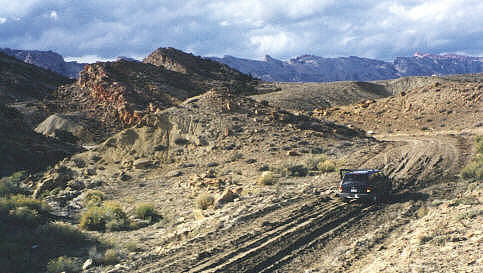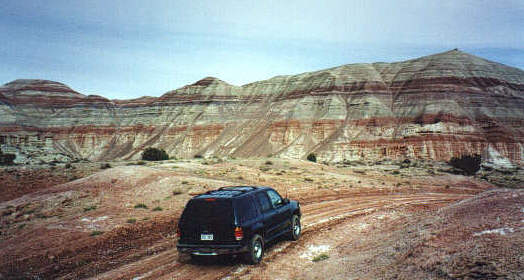
Discovering America's West

|
The wind will not stop. Gusts of sand swirl before me, stinging my face. But there is still
too much to see and marvel at, the world very much alive in the bright light and wind, exultant
with the fever of spring, the delight of morning ...
|
Between 1988 and 2022, I spent many vacations in the western part of the USA, traveled
more than 100,000 miles there, visited most of the national parks and national monuments,
and developed a special affection for deserts, badlands, and other wilderness areas.
The scenery of the West is truly spectacular and there is much to discover if you have the
courage to leave the beaten path. However, not every dirt track or jeep trail is marked on
road maps, and road conditions may vary between dusty, bumpy, muddy, and impassable. Do not
expect roadsigns everywhere. Be prepared to help yourself. The backcountry is as rough and
unforgiving as it is beautiful, and there is no gas station or repair shop around the corner.
 |
Muddy Dirt Road near Capitol Reef National Park, Utah
The following list contains most of the places I have visited. Some of them, like Grand Canyon, Yosemite,
Zion, or Yellowstone, are highly commercialized areas notoriously crowded with tourists, and I usually
don't go there anymore. There are other, less "developed" places, including real gems that are no
less inspiring. If you accept the challenge of driving adventurous backroads, you will be rewarded
with breathtaking vistas, interesting geological features, or the sight of rare plants and animals.
Washington:
North Cascades NP, Mt. St. Helens Nat'l Volcanic Monument, Mt. Rainier NP, Glacier NP, Olympic NP, Beacon Rock SP, Dry Falls Heritage Area (on Hwy 17)
Oregon:
Steens Mountain, Alvord Desert, Malheur Lake, Diamond Craters, Hole in the Ground,
Fort Rock SP, Newberry Crater NM, Crater Lake NP, Cascade Range, John Day Fossil Beds NM, Hells Canyon NRA
North Dakota:
Theodore Roosevelt NP
South Dakota:
Badlands NP and Pine Ridge Indian Reservation, Reva Gap and The Castles, Black Hills and Custer SP
Nebraska:
Scotts Bluff NM, Agate Fossil Beds NM
Wyoming:
Yellowstone NP, Grand Teton NP, Devil's Tower NM, Bighorn Mountains, Bighorn Canyon NM, Fossil Butte NM,
Flaming Gorge NRA
Idaho:
Sawtooth Mountains, Craters of the Moon NM
Nevada:
Pyramid Lake, Highway 50, Great Basin NP, Ruby Mountains, Lamoille Canyon, Ruby Marshes, Lunar Crater, Valley
of Fire SP, Red Rock Canyon
Utah:
House Range, Tule Valley, Sevier Lake, Grand Staircase Escalante NM, Cathedral Valley, South Desert,
Goblin Valley, Temple Mountain & McKay Flat, Factory Butte, Waterpocket Fold, Burr Trail, San Rafael Swell,
Canyonlands NP, Shafer Trail, Dead Horse Point SP, Arches NP, Cedar Breaks NM, Zion NP, Bryce Canyon NP, Red
Canyon, Snow Canyon SP, Coral Pink Sand Dunes SP, Cottonwood Canyon, La Sal Mountains, Henry Mountains, Lake Powell,
White Canyon, Comb Ridge, Abajo Mountains, Valley of the Gods, Goosenecks SP, Split Mountain, Fantasy Canyon
Utah/Colorado:
Dinosaur NM, Harper's Corner Trail
Colorado:
Rocky Mountain NP, Pikes Peak, Garden of the Gods, Curecanti NRA, Black Canyon of the Gunnison NP, Great
Sand Dunes NM, Echo Park, Gates of Lodore
Arizona:
Monument Valley, Grand Canyon NP, Wupatki NM, Sunset Crater NM, Walnut Canyon NM, SP Crater,
Meteor Crater, Canyon de Chelly NP, Petrified Forest NP, Salt River Canyon, Saguaro NM, Organ
Pipe Cactus NM, Chiricahua NM, Tonto NM, Apache Trail, Montezuma Castle NM, Picacho Peak SP,
Horseshoe Bend
New Mexico:
Shiprock Peak, El Morro NM, El Malpais NM, Gila Cliff Dwellings NM, City of Rocks SP, White Sands NM,
Carlsbad Caverns NP, Valley of Fires SP, Bisti Wilderness
California:
Yosemite NP, Sequoya NP, Joshua Tree NP, Death Valley NP, Mt. Whitney, Alabama Hills, Obsidian Dome,
Mono Lake, Devil's Postpile NM, Redwood NP, Avenue of the Giants, Lassen Volcanic NP, Pinnacles NM,
Salton Sea, Yuha Desert
Texas:
Guadalupe Mountains NP, Big Bend NP
Furthermore, I visited a few parks and other scenic places in the eastern USA:
New York:
Niagara Falls SP, Finger Lakes, Taughannock Falls SP, Adirondack Mountains
Ohio:
Cuyahoga Valley NP, Lake Milton SP
Tennessee / North Carolina:
Great Smoky Mountains NP
Vermont / New York:
Lake Champlain
Virginia:
Shenandoah NP, Luray Caverns
Visit my 2001 photo gallery.
Visit my 2002 photo gallery.
Visit my 2003 photo gallery.
Visit my 2004 photo gallery.
Visit my 2005 photo gallery.
Visit my 2008 photo gallery.
Visit my 2010 photo gallery.
Visit my 2014 photo gallery.
Visit my 2019 photo gallery.
Visit my 2022 photo gallery.
Visit my 2024 photo gallery.
Visit my 2025 photo gallery.
Visit my black-and-white photo gallery (old photos).
Visit my black-and-white photo gallery (newer photos).
Going to the desert or other wilderness without proper preparation and planning is like buying a one-way ticket. For those who want to explore the backcountry I have a couple of recommendations resulting from on my own experience* :
Make yourself familiar with survival rules and the fundamentals of land navigation before you enter any
desert or other wilderness area. Your navigational equipment should include a topograhic map or atlas of the
respective area, a compass, a GPS navigator (a small, hand-held GPS is ok), a notepad, a pencil, a protractor,
a ruler, and a pocket calculator.
Inform yourself about the areas you are planning to visit. Inquire about current road conditions (including
river fords). Listen to the local weather forecast. Sources of information are BLM offices, web sites, radio
stations, chambers of commerce, local people, and near-by facilities like visitor centers and ranger stations.
Knowing the local magnetic declination may be important since the latter is considerable in some areas, and a
magnetic compass may become almost useless if no correction is applied. In some national parks, you are
required to register before going on a backcountry trip (don't forget to sign out afterwards!).
If you happen to be a licensed radio amateur, take a portable shortwave transceiver with you. This may be the
only means of communication with the outside world in case of emergency since cellular phones don't work in
remote areas. Even a CB radio is still better than nothing.
After leaving the last known road, stop at every fork or crossroad, mark your GPS position, and note which way
you are going. Following this rule, you can always find your way back to the starting point. Do not only rely on
GPS. Try to identify each waypoint on the map. Stay alert and look out for prominent landmarks. If you go hiking,
store the GPS coordinates of the parking lot. This makes it easier to find the way back to your car.
Use a high-clearance 4WD car or pick-up truck if possible. Stopping in front of an impassable ford or mud hole
after driving fifty miles of bumpy dirt road in a passenger car is quite frustrating. Shock absorbers or mufflers
damaged by rocks are no fun either. Buy enough gas and check the tire pressure (including the spare tire). Check
if the tool kit of the car is complete (jack!). A rope may be needed to tow your (or somebody else's) car in case
of a breakdown.
Keep a shovel or spade in your car unless you stay on improved roads. You will need it sooner or later, believe me.
Take plenty of drinking water and food for a couple of days with you. Taking camping gear on the trip may also
be a good idea, even if you are not planning to stay overnight. If you get stuck, don't panic. You may have to
spend a few hours or days in the desert but sooner or later some hunter, rock collector, or off-road biker will
find you. I made the experience that even the most remote areas in the US (with the exception of Alaska maybe)
are not entirely deserted, and every couple of hours you will probably see somebody as long as you don't leave
the trail.
Don't forget a hat, sun glasses, sun lotion, insect repellent, and a first-aid kit. In addition, a snake bite kit
may be useful. I saw only two rattlesnakes in thirty-five years, but you never know. Wear boots, not sandals, even when
it is hot outside. Tweezers and a magnifying glass may come in handy for removing ticks, thorns, cactus spines, and
the like.
Observe the weather carefully. Dirt roads, particularly clay roads, may quickly become impassable when getting
wet and may cut off your way back. Be careful when entering canyons, ravines, dry river beds, or other low terrain
during or after rainstorms (even distant ones!) since dangerous flash floods may occur with little or no warning.
If you see or hear signs of an approaching flash flood, seek higher ground immediately!
Stay on trails. Off-road driving may damage vegetation and soil. A landscape defaced by tire tracks is not a pleasant
view. Be careful with campfires in dry weather (observe warning signs, ask a park ranger). Don't throw away bottles,
cans, candy wrappers, etc. The wilderness is no garbage dump.
Do not just drive. Move your butt out of the car and walk! Take you time. Enjoy the scenery, the solitude, and the
stillness. Breathe the clean air, smell the fragrance of the vegetation. You will learn very soon that exploring the
wilderness on foot is something different, and you will discover details not seen before.
* Click here for more details.
 |
Bentonite Hills, Capitol Reef National Park, Utah
Links:
US National Park Service
Bureau of Land Management
US Geological Survey
State Geological Surveys
Arizona Regional Image Archive
The American Southwest
Desert USA
Moon Handbooks Four Corners
Surviving out in the Desert Southwest
Arizona-Sonora Desert Museum
Discovering Lewis & Clark
Library of Western Fur Trade Historical Source Documents
Here are some wilderness or nature related books I have enjoyed reading:
| Edward Abbey: Desert Solitaire − A Season in the Wilderness | [ISBN 0345326490] |
| John Wesley Powell: The Exploration of the Colorado River and Its Canyons | [ISBN 0486200949] |
| Frank Bergon (ed.): The Journals of Lewis & Clark | [ISBN 0140252177] |
| Patrick Gass, Carol Lynn MacGregor: The Journals of Patrick Gass | [ISBN 0878423516] |
| John Mack Faragher: Daniel Boone − The Life and Legend of an American Pioneer | [ISBN 0805030077] |
| Stanley Vestal: Jim Bridger − Mountain Man | [ISBN 0803257201] |
| George R. Stewart: Ordeal by Hunger − The Story of the Donner Party | [ISBN 0395611598] |
| George Frederick Ruxton: Life in the Far West | [ISBN 0806115343] |
| John Muir: My First Summer in the Sierra | [ISBN 0140255702] |
| John Steinbeck and Edward Ricketts: Sea of Cortez: A Leisurely Journal of Travel and Research | [ISBN 0143117211] |
The following book is not directly related to nature. It is the story of an adventurous road trip across the USA shortly after the First World War. This book is
a real gem, and I can highly recommend it:
C. K. Shepherd: Across America by Motor-Cycle [ISBN 1163974684]
Last but not least, I would like to draw your attention to Ansel Adams (1902-1984), famous photographer and conservationist. His images of the American West are legendary. To get a first impression, visit The Ansel Adams Gallery. If you want to learn something about fine photography, you should read his following books:
| The Camera | [ISBN 0821221841] |
| The Negative | [ISBN 0821221868] |
| The Print | [ISBN 0821221876] |
Some of his best photos are included in:
| Classic Images | [ISBN 0821216295] |
If you are interested in other parts of the world, go to Lutz Kirchner's web site. Among many others, he has beautiful photos of Sibiria and Kamchatka.
